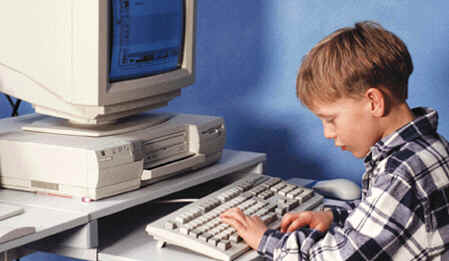Thirty
Students, One Computer,
Always Busy!
Some
tried and true ideas that work in the one-computer
classroom.
By Mary Storey
Many teachers find it a challenge
to make full use of just one or two computers in the
classroom. But experience shows that there are some
tried and true ideas that work in the one-computer
classroom.
It’s best
to have only one student at a time use the computer
for word processing or drawing using graphics
software. Each student has ownership of their own
ideas and it’s difficult to get two or three
students to write a creative story or draw a picture.
The second or third student can go to the computer
when it’s time to edit the story or evaluate the
picture.
For simulation
software programs such as those for history, science
or geography, two or three students gathered around
the computer is most effective. One student can
control the keyboard, one student does the oral
reading from the screen and the third student makes
notes, completes a work sheet or keeps a diary of the
decisions made or events that happen in the software.
If these
students rotate their jobs every 10 minutes the
written work is completed in three different writing
styles and every student gets to use the keyboard.
Ideal
for brainstorming
The computer
helps teach students how to brainstorm, and this new
skill will make more effective use of the hardware.
Because many of our students do not have good typing
skills, the student at the computer will take a
longer time to enter their ideas into the computer.
However, they will catch up with the rest of the
class when the editing happens. This can be done much
faster in word processing than making a second copy
with a pen or pencil.
Try to organize
classroom activities so that different students use
software for different units and all students get an
effective, longer time at the computer, rather than a
short ineffective time daily. It is better for
students to have a worthwhile longer experience at
the computer than a shorter non-curriculum
experience.

Not every
student will use every piece of software and they can
keep records of the use with a class list pinned
above the computer. The other third or half the class
will use a different piece of software for the next
unit and get somewhat equal use of the computer.
Get
everyone involved with newsletters
When students
are researching a topic and entering the data into
databases or game creators, many students will use
the computer for a short period of time to create a
collective product. This also works in the creation
of a poetry newsletter or a newsletter about a
country the class is studying, where each student
types a small part of the final product.
Whole class
instruction can take place when the teacher pulls the
computer to the front on a table, seats the students
on the carpet and demonstrates new software. The
complete class is learning via a lesson on the
computer while the teacher uses the keyboard. This
would be an introductory how-to lesson before the
students work on the same software in small groups
during the length of the unit.
Each time
students are asked to pick up a pen or pencil, one
student can be at the computer using word processing.
This could happen when the students are doing
spelling exercises or dictation, grammar exercises, a
science note, response to a novel, a video or a
current events issue. Student work can be printed and
inserted in the appropriate notebook. Using this
method, four or five students a day can use the
classroom computer
Always send the
students to the computer with a task to do – and
it should be one that results in a product that can
be evaluated. Using the computer when students
complete their work or as a game machine is not the
reason we have computers in our classrooms.
Mary Storey has 25 years
experience as an elementary teacher and is a Prime
Minister’s Award recipient for excellence in
teaching mathematics, science and technology. For the
past seven years, she has been a computer consultant
for the York Region Board of Education.